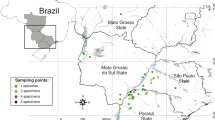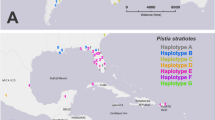Abstract
Species of Alnus (alders) have become invaders in several parts of the world. Here we report the presence of three naturalized alien species: A. glutinosa, A. incana and A. rubra from several populations in nature reserves of northwestern Patagonia, an area of remarkably high biodiversity. Alnus glutinosa had been cited previously for Chile and southern Argentina, but A. incana and A. rubra are here reported for the first time. As we found morphological variation within and among the populations of these introduced species that makes their discrimination difficult, we used chloroplast (trnH-psbA) and nuclear ribosomal (ITS) DNA sequences to confirm their identifications from morphological characteristics. Results from nuclear and chloroplast sequence data confirm the morphological tentative identification of the three species and remark the utility of molecular information together with morphology for the detection of introduced species of taxonomically difficult groups. The invasive characteristics of these alien tree species are discussed in relation to the conservation of the nature reserves where they are found.


Similar content being viewed by others
References
Banaev EV, Bažant V (2007) Study of natural hybridization between Alnus incana (L.) Moench. and Alnus glutinosa (L.) Gaertn. J For Sci 53:66–73
Bogar LM, Dickie IA, Kennedy PG (2015) Testing the co-invasion hypothesis: ectomycorrhizal fungal communities on Alnus glutinosa and Salix fragilis in New Zealand. Divers Distrib 21:268–278
Chaia EE, Wall LG, Huss-Danell K (2010) Life in soil by the actinorhizal root nodule endophyte Frankia, a review. Symbiosis 51:201–226
Chen Z, Li J (2004) Phylogenetics and biogeography of Alnus (Betulaceae) inferred from sequences of nuclear ribosomal DNA ITS region. Int J Plant Sci 165:325–335
Csurches S, Edwards R (1998) Potential environmental weeds in Australia. Queensland Department of Natural Resources, Canberra
Edwards P (2011) Condiciones que influyen en la invasión de especies riparias introducidas del género Alnus (Betulaceae) en dos Parques Nacionales de Patagonia Norte. Tesis para optar por el grado de Licenciado en Ciencias Biológicas. Universidad Nacional del Comahue, San Carlos de Bariloche
Ezcurra C, Calviño CI (2017) (in press) Betulaceae. In: Zuloaga F, Belgrano M (eds) Flora Argentina. IBODA CONICET, Buenos Aires
Furlow JJ (1997) Betulaceae. In: Committee Editorial (ed) Flora of North America, vol 3. Oxford University Press, Oxford, pp 507–538
Gaertner M, Biggs R, Te Beest M, Hui C, Molofsky J, Richardson DM (2014) Invasive plants as drivers of regime shifts: identifying high-priority invaders that alter feedback relationships. Divers Distrib 20:733–744
Hollingsworth PM, Li DZ, van der Bank M, Twyford AD (2016) Telling plant species apart with DNA: from barcodes to genomes. Philos Trans R Soc Lond B Biol Sci 371(1702):20150338
Koutché V (1942) Estación Forestal de Puerto Anchorena, Isla Victoria; su organización y trabajos. Ministerio de Agricultura, Dirección de Parques Nacionales, Buenos Aires
Li P, Skvortsov AK (1999) Betulaceae. In: Wu C, Raven PH, Hong D (eds) Flora of China, vol 4. Science Press, Beijing, pp 286–313
Li DZ, Gao LM, Li HT et al (2011) Comparative analysis of a large dataset indicates that internal transcribed spacer (ITS) should be incorporated into the core barcode for seed plants. PNAS 108:19641–19646
Navarro E, Bousquet J, Moiroud A, Munive A, Piou D, Normand P (2003) Molecular phylogeny of Alnus (Betulaceae), inferred from nuclear ribosomal DNA ITS sequences. Plant Soil 254:207–217
Rejmánek M, Richardson DM (1996) What attributes make some plant species more invasive? Ecology 77:1655–1661
Rejmánek M, Richardson DM (2013) Trees and shrubs as invasive alien species—2013 update of the global database. Divers Distrib 19:1093–1094
Ren BQ, Xiang XG, Chen ZD (2010) Species identification of Alnus (Betulaceae) using nrDNA and cpDNA genetic markers. Mol Ecol Resour 10:594–605
Richardson DM, Hui C, Nuñez MA, Pauchard A (2014) Tree invasions: patterns, processes, challenges and opportunities. Biol Invasions 16:473–481
Sakai AK, Allendorf FW, Holt JS et al (2001) The population biology of invasive species. Annu Rev Ecol Syst 32:305–332
Simberloff D, Relva MA, Nuñez M (2002) Gringos en el bosque: introduced tree invasion in a Nothofagus/Austrocedrus forest. Biol Invasions 4:35–53
Simberloff D, Nuñez MA, Ledgard NJ, Pauchard A, Richardson DM, Sarasola M, Van Wilgen BW, Zalba SM, Zenni RD, Bustamante R, Peña E, Ziller SR (2010) Spread and impact of introduced conifers in South America: lessons from other southern hemisphere regions. Austral Ecol 35:489–504
Speziale K, Ezcurra C (2011) Patterns of alien plant invasions in northwestern Patagonia, Argentina. J Arid Environ 75:890–897
Stamatakis A (2006) RAxML-VI-HPC: maximum likelihood-based phylogenetic analyses with thousands of taxa and mixed models. Bioinformatics 22:2688–2690
Swofford DL (2002) PAUP*. Phylogenetic analysis using parsimony (*and other methods). Version 4. Sinauer Associates, Sunderland
Tutin TG, Heywood VH, Burges NA, Valentine DH, Walters SM, Webb DA (1964) Lycopodiaceae to platanaceae. In: Tutin TG (ed) Flora Europaea 1. Cambridge University Press, London, p 498
Wiser S, Allen R (2006) What controls invasion of indigenous forests by alien plants? Biol Invasions NZ 186:195–209
Zuloaga FO, Morrone O, Belgrano M (2008) Dicotyledoneae: Acanthaceae—Fabaceae. In: Zuloaga FO, Morrone O, Belgrano M (eds) Catálogo de las Plantas Vasculares del Cono Sur 2. Missouri Botanical Garden Press, St. Louis, pp 985–2285
Acknowledgements
The authors are grateful to park rangers of Lanín National Park for fieldwork assistance and to Nahuel Huapi National Park Administration (APN) for partial financial support to PE. Our appreciation to three anonymous reviewers for useful comments on the manuscript. We also acknowledge funding from Universidad Nacional del Comahue PIN B205, CONICET PIP 112-201301-00357, and ANPCyT-FONCyT PICT 2014-0584.
Author information
Authors and Affiliations
Corresponding author
Rights and permissions
About this article
Cite this article
Calviño, C.I., Edwards, P., Fernández, M. et al. Not one but three: undetected invasive Alnus species in northwestern Patagonia confirmed with cpDNA and ITS sequences. Biol Invasions 20, 2715–2722 (2018). https://doi.org/10.1007/s10530-018-1744-x
Received:
Accepted:
Published:
Issue Date:
DOI: https://doi.org/10.1007/s10530-018-1744-x




